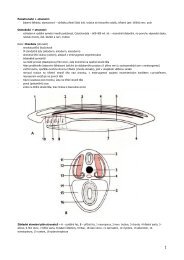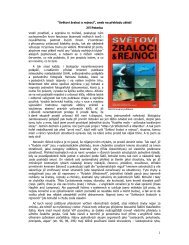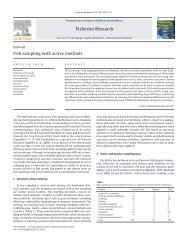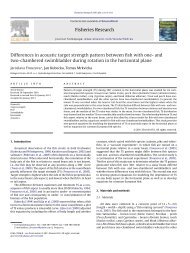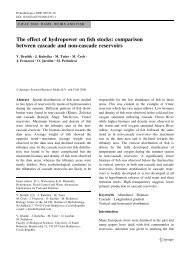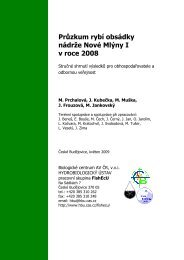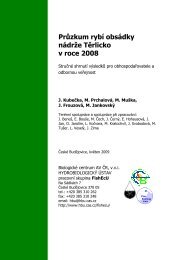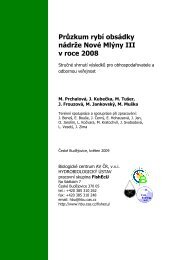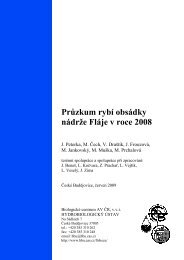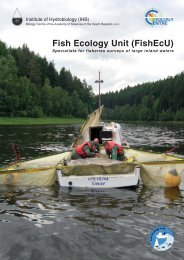anglicky - Institute of Hydrobiology
anglicky - Institute of Hydrobiology
anglicky - Institute of Hydrobiology
Create successful ePaper yourself
Turn your PDF publications into a flip-book with our unique Google optimized e-Paper software.
pools in forest and alpine meadow soils <strong>of</strong> European glaciated areas (soils <strong>of</strong> similar age as<br />
the emissions).<br />
Despite large uncertainties in the model (13.7–30.5 Pg N over the last 10,000 years), the<br />
relative temporal distributions <strong>of</strong> total cumulative Nr emissions vary within relatively narrow<br />
ranges for different assumptions, with 70–84% <strong>of</strong> the emissions occurring prior to 1850. We<br />
conclude that the majority <strong>of</strong> the total cumulative anthropogenic Nr emission over the last<br />
10,000 years occurred in the pre-industrial period and could have increased soil N pools <strong>of</strong><br />
some remote ecosystems much earlier than is currently assumed.<br />
Anthropogenic Nr emission (Tg yr -1 ).<br />
3000 BC 1000 1700 1913 1980 2000<br />
30<br />
25<br />
LIV<br />
FER<br />
20<br />
H&P<br />
AWB<br />
15<br />
FSB<br />
10<br />
FFC<br />
5<br />
0<br />
10000 1000 100 10 1<br />
Year before present<br />
90<br />
80<br />
70<br />
60<br />
50<br />
40<br />
30<br />
20<br />
10<br />
0<br />
3000 BC 1000 1700 1913 1980 2000<br />
Nr<br />
NH3-N<br />
NOx-N<br />
10000 1000 100 10 1<br />
Year before present<br />
Fig. 8: Global N-emissions from livestock production (LIV), application <strong>of</strong> synthetic N-fertilizers<br />
(FER), human excreta and domestic pets (H&P), burning <strong>of</strong> agricultural waste and bi<strong>of</strong>uel<br />
(AWB), forest and savannah burning (FSB), fossil fuel combustion (FFC), and total emissions<br />
<strong>of</strong> NH 3 –N, NO x –N, and total reactive N (Nr). Time is expressed in logarithmic scale<br />
(1 = year 2000; numbers on top are calendar years).<br />
5.4 Canopy leaching <strong>of</strong> nutrients and metals in a mountain spruce forest<br />
J. Kopáček (jkopacek@hbu.cas.cz), J. Turek, J. Hejzlar, and P. Porcal measured element<br />
concentrations and fluxes in bulk precipitation (two sites) and throughfall (four sites) in<br />
Norway spruce mountain stands in the Bohemian Forest (Czech Republic) from 1998–2009,<br />
with the aim to evaluate net atmospheric inputs <strong>of</strong> nutrients to the area, and (together with<br />
previous data from 1991–1997) long-term trends in acidic deposition. The average net<br />
atmospheric inputs <strong>of</strong> nutrients were 11, 4, 9, 62, 62, 45, 26, and 0.7–1.3 mmol m –2 yr –1 for<br />
Ca 2+ , Mg 2+ , K + , NO 3 – , NH 4 + , total organic N, S, and total P (TP), respectively. The TP<br />
deposition was affected by a notable contribution from local dust and pollen sources.<br />
Throughfall pH increased from 3.6–3.7 in 1991–1994 to 4.7–5.0 in 2006–2009, due to<br />
average declines in the SO 4 2– plus NO 3 – concentrations by 202 µeq l –1 and the H +<br />
concentration by 147 µeq l –1 . The decline in throughfall concentrations <strong>of</strong> SO 4 2– (by 184 µeq<br />
l –1 ) was the dominant driving force for the pH increase.<br />
35



